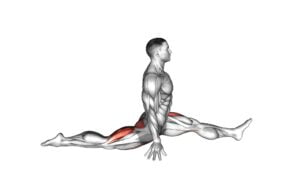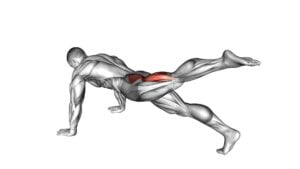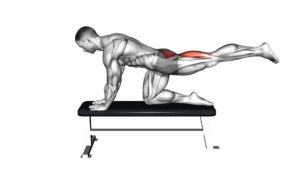Hip – Extension – Video Exercise Guide & Tips

In this guide, you'll discover the benefits, proper form, and variations of hip extension exercises.
Watch This Exercise Video
Whether you're a fitness enthusiast or rehabilitating an injury, this video exercise guide will help you achieve optimal results.
Avoid common mistakes and learn tips for progressing and increasing intensity in your hip extension training.
Get ready to strengthen and tone your hip muscles with this informative and authoritative resource.
Let's get started!
Key Takeaways
- Hip extension exercises improve overall strength and mobility.
- They are crucial for athletic performance and enhance the ability to generate force from the ground.
- These exercises help improve posture by strengthening the hip extensors.
- Regular hip extension exercises can alleviate lower back pain.
Benefits of Hip Extension Exercises
Improve your overall strength and mobility with hip extension exercises. Hip extension is a crucial movement for athletic performance and plays a significant role in improving your posture.
When it comes to athletic performance, hip extension is essential for generating power and speed. It's a fundamental movement pattern used in activities such as sprinting, jumping, and lifting weights. By strengthening your hip extensors, you can enhance your ability to generate force from the ground, resulting in improved athletic performance.
Furthermore, hip extension exercises can also help improve your posture. Weak hip extensors can contribute to poor posture, as they're responsible for maintaining the alignment of the pelvis and spine. By strengthening these muscles, you can alleviate lower back pain and promote a more upright posture.
Some effective hip extension exercises include squats, deadlifts, lunges, hip thrusts, and glute bridges. These exercises target the glutes and hamstrings, which are the primary hip extensor muscles. Incorporating these exercises into your workout routine can help you develop stronger and more functional hips, leading to improved athletic performance and better posture.
Proper Form and Technique for Hip Extension
To ensure proper form and technique for hip extension exercises, use a slight hip hinge and engage your glutes and hamstrings while keeping your core tight. This will help you maximize the benefits of hip extension and prevent injuries. By hinging at the hips, you allow for a greater range of motion and target the posterior chain muscles more effectively. Engaging your glutes and hamstrings ensures that these muscles are doing the majority of the work, rather than relying on other muscles to compensate. It also helps to maintain a neutral spine position, which is crucial for proper form. Additionally, keeping your core tight throughout the movement provides stability and support.
When it comes to hip extension progressions, there are several options to challenge yourself as you get stronger. You can start with basic hip extension exercises, such as glute bridges or hip thrusts, and gradually increase the resistance by using a barbell or adding weights. Another progression is performing single-leg hip extensions, which further engage the glutes and hamstrings while also improving balance and stability. Other variations include hip extension exercises using resistance bands or stability balls.
Variations of Hip Extension Exercises
Now let's explore different ways to challenge yourself and target your glutes and hamstrings with various hip extension exercise variations. Adding variety to your hip extension routine isn't only exciting but also effective for strength training. Incorporating different hip extension variations into your workouts can help you engage different muscle fibers and prevent plateaus in your progress.
One variation of hip extension is the single-leg hip extension. This exercise involves extending one leg at a time while keeping the other leg bent. By focusing on one leg at a time, you can increase the intensity and really target your glutes and hamstrings.
Another variation is the hip thrust exercise. This exercise requires you to lie on your back with your knees bent and lift your hips off the ground. By using a bench or step, you can increase the range of motion and challenge your glutes and hamstrings even more.
Lastly, the resistance band hip extension is a great way to add resistance to your hip extension exercises. By attaching a resistance band around your ankles and performing hip extensions, you can further strengthen your glutes and hamstrings.
Incorporating these different hip extension variations into your strength training routine won't only keep your workouts interesting but also help you target and strengthen your glutes and hamstrings more effectively.
Common Mistakes to Avoid During Hip Extension
To ensure proper form and maximize the effectiveness of your hip extension exercises, it's crucial to avoid these common mistakes. By being mindful of these errors, you can reduce the risk of injury and make the most out of your training:
- Using Momentum: One of the most common mistakes during hip extension exercises is relying on momentum to lift the leg. This not only reduces the engagement of the targeted muscles but also puts unnecessary strain on the joints. Focus on controlled movements and use your muscles to initiate the extension.
- Arching Your Back: It's important to maintain a neutral spine position throughout the exercise. Arching your back can lead to excessive stress on the lower back and diminish the effectiveness of the movement. Keep your core engaged and your spine in a neutral alignment.
- Neglecting Proper Alignment: Another common mistake is letting your leg drift out of alignment. This can happen when the leg rotates outward or inward during the extension. Maintain proper alignment by keeping the knee and toes pointing straight ahead.
By avoiding these common mistakes, you can ensure that your hip extension exercises are performed correctly and safely.
Now, let's move on to the next section, where we'll discuss tips for progressing and increasing intensity in hip extension training.
Tips for Progressing and Increasing Intensity in Hip Extension Training
To progress and increase the intensity in your hip extension training, you can incorporate these tips into your routine.
There are several progression methods you can utilize to challenge your hip muscles further. One effective method is to increase the weight or resistance used during exercises such as hip thrusts or glute bridges. You can do this by using a barbell, resistance bands, or ankle weights.
Another way to progress is by increasing the number of sets and repetitions you perform. Gradually adding more sets and reps will help to build strength and endurance in your hip muscles.
Additionally, you can try advanced hip extension techniques to further intensify your training. These techniques include single-leg variations, such as single-leg hip thrusts or single-leg glute bridges, which require more stability and engage the muscles even more.
Another advanced technique is incorporating explosive movements, such as kettlebell swings or jumping lunges, to challenge your hip muscles in a dynamic way.
Frequently Asked Questions
How Many Times a Week Should I Perform Hip Extension Exercises?
To get the most out of your hip extension exercises, it's important to do them consistently. Aim to perform hip extension exercises at least three to four times a week.
This will help you build strength and improve your athletic performance. Remember to focus on proper form and technique to maximize the benefits. Engage your glute muscles, keep your back straight, and avoid any excessive arching.
Stay dedicated and you'll see results in no time.
Can Hip Extension Exercises Help With Lower Back Pain?
Hip extension exercises can be beneficial for improving overall strength and mobility. They play a crucial role in preventing lower back injuries by strengthening the muscles in the hips and supporting the spine.
Are There Any Modifications or Alternatives for People With Limited Hip Mobility?
If you have limited hip mobility, there are modifications and alternatives available for you.
In yoga, you can use props like blocks or straps to help support your body during hip extension exercises.
For desk workers, incorporating exercises like standing hip extensions or seated hip flexor stretches can be beneficial.
It's important to consult with a fitness professional or physical therapist to determine the best modifications for your specific needs.
Can Hip Extension Exercises Improve Running Performance?
Hip extension exercises can greatly improve your running performance, regardless of whether you're a sprinter or a long-distance runner. By incorporating hip extension exercises into your training routine, you can strengthen the muscles in your hips and glutes, which are essential for generating power and speed while running.
These exercises help improve stride length, increase running efficiency, and reduce the risk of injury. So, if you want to take your running to the next level, hip extension exercises are definitely worth incorporating into your training regimen.
What Are Some Stretches That Can Complement Hip Extension Exercises?
To complement your hip extension exercises and improve flexibility, incorporate stretching techniques into your routine.
Stretching the hip flexors, such as with a kneeling hip flexor stretch, can help lengthen these muscles and enhance hip extension.
Additionally, stretching the glutes and hamstrings, like with a seated forward fold, can also contribute to improved hip extension.
Remember to warm up before stretching and listen to your body, taking precautions to avoid overstretching or causing injury.
Conclusion
Incorporating hip extension exercises into your workout routine can offer numerous benefits. This includes strengthening your glutes, hamstrings, and lower back. By maintaining proper form and technique, you can maximize the effectiveness of these exercises and minimize the risk of injury.
There are various variations of hip extension exercises that you can try to target different muscle groups. It's important to avoid common mistakes, such as arching your back or using momentum, to ensure optimal results.
As you progress in your training, gradually increase the intensity of your hip extension exercises. This will help promote continued growth and improvement.

Author
Years ago, the spark of my life’s passion ignited in my mind the moment I stepped into the local gym for the first time. The inaugural bead of perspiration, the initial endeavor, the very first surge of endorphins, and a sense of pride that washed over me post-workout marked the beginning of my deep-seated interest in strength sports, fitness, and sports nutrition. This very curiosity blossomed rapidly into a profound fascination, propelling me to earn a Master’s degree in Physical Education from the Academy of Physical Education in Krakow, followed by a Sports Manager diploma from the Jagiellonian University. My journey of growth led me to gain more specialized qualifications, such as being a certified personal trainer with a focus on sports dietetics, a lifeguard, and an instructor for wellness and corrective gymnastics. Theoretical knowledge paired seamlessly with practical experience, reinforcing my belief that the transformation of individuals under my guidance was also a reflection of my personal growth. This belief holds true even today. Each day, I strive to push the boundaries and explore new realms. These realms gently elevate me to greater heights. The unique combination of passion for my field and the continuous quest for growth fuels my drive to break new ground.







